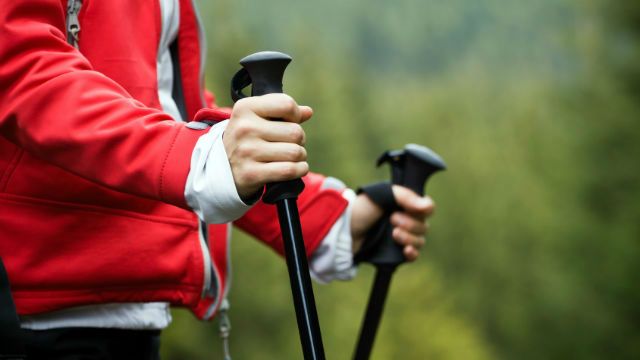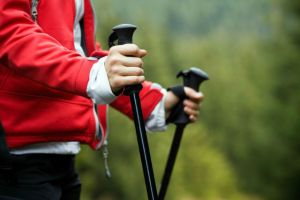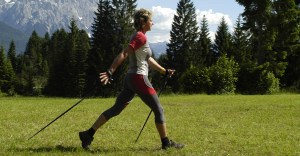BRIEF INFORMATION ABOUT NORDIC WALKING A TOTAL BODY VERSION OF WALKING
Nordic walking is a total body version of walking that can be enjoyed both by non-
athletes as a health-promoting physical activity, and by athletes as a sport. The activity is performed with specially designed walking poles similar to ski poles.
Walking is a highly recommended exercise for those of lymphedema of either the lower or upper extremities. A newer variation on this activity, known Nordic Walking, had its origin in Finland in 1997, and is rapidly becoming popular all over the world and can be enjoyed in summer and winter. Nordic walking has special benefits for those with lymphedema and is a very enjoyable activity to share with a group.
WHAT IS NORDIC WALKING?
Nordic Walking is fitness walking with specially designed Nordic Walking poles that offers an efficient, aerobic, and easy way to improve your physical condition irrespective of age, sex, or physical condition.
Nordic Walking combines the positive training effects of running combined with the advantages of cross-country skiing. This exercise, which uses a form of modified ski poles, was originated by cross country skiers as a way of exercising during the summer.
POSITIVE POINTS
The use of the poles and the specific hold-relax technique of the forearm muscles turns out to be very benficial for people in general and lymphedema patients in particular.
Compared with regular walking, Nordic Walking puts less strain on the body and the rate of perceived exertion is the same as walking without the poles. However, there are numerous benefits as shown on this list:
- Improves metabolism so caloric expenditure, and energy consumption, are increased by an average of 20 percent.
- Oxygen consumption increases by as much as a 46 percent.
- The heart rate increaseds by 7 to 10 beats per minute.
- This low impact activity causes less stress on the joints.
- Improves upper body strength.
- Effectively releases shoulder and neck tension. This allows the intensity of running without the impact
- Allows active exercise with stability and safety on slippery surfaces.
Benefits
Compared to regular walking, Nordic walking (also called pole walking) involves applying force to the poles with each stride. Nordic walkers use more of their entire body (with greater intensity) and receive fitness building stimulation not present in normal walking for the chest, latissimus dorsi muscle, triceps, biceps, shoulder, abdominals, spinal and other core muscles that may result in significant increases in heart rate at a given pace.[3] Nordic walking has been estimated as producing up to a 46% increase in energy consumption, compared to walking without poles.[4][5]According to the findings of the research, conducted by the group scientists from various universities*, both Nordic walking and conventional walking are beneficial for older adults. However, Nordic walking provides additional benefits in muscular strength compared to conventional walking, making it suitable for improving aerobic capacity and muscular strength as well as other components of functional fitness in a short period of time. The key points stated by the study authors are: Nordic walking, conventional walking, and resistance training are beneficial for older adults.- Nordic walking and conventional walking both improve cardio-respiratory fitness while resistance training does not.
- Nordic walking provides additional benefits in upper-body muscular strength compared to conventional walking.
- Nordic walking is an effective and efficient mode of exercise to improve overall fitness in older adults.
- The added stability of using the poles enable those who need a cane to walk more easily and with less fear of falling.
- The support of the arms by holding the poles minimizes the strain on the shoulder joint.
- The specific technique of holding the poles and relaxing the grip while swaying the arms activates the muscle pump of the forearm muscles.
- The hold-relax actions of the forearm muscles contribute to the extra lymph to flow out of the arm.
- These movements help to keep surgery and/or radiation scars supple. Provides a great cardiovascular workout
-
- National Institute of Fitness and Sports in Kanoya, Kanoya, Japan; Department of Rehabilitation, Yonaha General Hospital, Kuwana, Mie, Japan; Wichita State University, Wichita, KS, USA; Active Aging Association, Nagoya, Japan; Nagoya City University, Nagoya, Japan. 2013
- More benefits are below:
- Like regular walking, Nordic Walking is great for your heart. Since Nordic Walking activates more of your body, however, it can provide even more of a workout, and some research has found that it burns more calories.Nordic Walking can be either leisurely or intensive, and you can easily work yourself up to the next level with practice. Some research has found that walking with arm activation can also increase energy expenditure, heart rate and oxygen uptake compared to walking without the use of the arms.Regular cardiovascular exercise can help reduce your risk of heart disease and stroke, as well as many other chronic ailments. It can also keep you looking and feeling your best. Nordic Walking is a great way to build endurance, and can be a great part of a weight loss plan, as well.Improves balance and coordinationThe movements that Nordic Walking require can improve both balance and coordination. To properly move the poles along with your stride requires moving your arms in opposition with your legs.When your upper and lower halves, and opposing muscle groups, must work together in this way, your entire body achieves greater balance. The more you practice, the better you can complete these motions at greater speeds.When you walk with the use of poles, it creates better balance and stability than walking without them. This can give us – especially those of us who are not so coordinated on our feet – the confidence to relax and look around as we walk. It can also improve visual coordination, as well as posture, which suffers when we look down at the ground too often.Engages numerous muscle groupsNordic Walking has been found to engage up to 90 percent of the muscles in the body. Muscle groups that are especially targeted are those of the abdomen, hips, thighs, buttocks and triceps. It may also help to increase all-over mobility, and reduce muscle pain. Some research has found that neck and shoulder pain was diminished after participants underwent this activity.On top of that, regular Nordic Walking can improve your muscular endurance, so that you can perform other exercises – and daily activities – with greater ease.Reduces strain on the jointsBecause the poles used for Nordic Walking pick up some of the weight of each step, they take some pressure off of the knees and other joints. This makes Nordic Walking an ideal exercise for older individuals, people with knee problems and those recovering from heart-related complications. It can be done at a gentle pace, so as to provide a great workout with minimum strain.Helps those with balance problems have a safer strollFor elderly individuals and those with equilibrium issues, walking with poles to balance them may greatly decrease the risk of a fall or similar incident. Additionally, the fact that Nordic Walking works the upper body as well is important for keeping bones and muscles strong.
Advantages of Nordic Walking
There are so many advantages of Nordic Walking, where shall we start? Many of our clients find that it improves their health and wellbeing by making them fitter, stronger and happier, and that it even reduces knee and back pain caused by arthritis. Often people go home with a spring in their step, feeling rejuvenated and ready for the rest of the day.So how do we do that?Nordic Walking makes you stronger and fitter
You don’t need heavy weights in order to get stronger and fitter. With Nordic Walking, we simply put every major muscle to work. Even though the levels of resistance are relatively low, as you walk, you will make thousands of repetitions without even thinking. In the average person, the effect is the same as in a gym – just less painful!“Nordic Walking is like cross-country skiing without the skis. By using the lightweight poles to propel your stride, you add the large muscles of your upper body to your standard walking workout. Besides toning your arms, shoulders, and chest muscles (and believe us, you do ‘feel the burn’ if you push hard), you also boost your cardiovascular workout. Holding the poles forces you to swing your arms. All in all, you will burn 30% or more calories than walking without the poles, according to research at the University of Wisconsin, Madison.”Nordic Walking makes you happier
Exercise really helps you feel better and happier. In fact, it can help with a whole range of psychological and mental health conditions, it can even improve your memory! And Nordic Walking ticks some other boxes of lifestyle changes you can make to feel happier too: Being out in nature (your local parks might surprise you!), relaxation and stress reduction, having fun and socialising with others, it is all part of Nordic Walking!Nordic Walking makes your bones stronger
It’s well established that low-impact weight bearing exercise is an important factor in the fight to ward off the effects of age-related osteoporosis. Forcing the bones to carry the weight of the body helps them to become denser and stronger as they are encouraged to pick up and use the calcium that a good diet, supplements or medication will supply.Doctors will often prescribe regular walking for sufferers of osteoporosis, but then also have to recommend some form of resistance workout to ensure the needs of the upper body body are also met. But with Nordic Walking we use all our muscles at once and kill two birds with one stone!Nordic Walking takes the Pressure off your Joints
Because part of the body’s weight is shifted from the spine to the shoulders, upper back and arms, many walkers with joint problems find walking with poles significantly less painful than that without poles, or even with a walking stick. You will feel the difference in posture immediately. And as your muscles get stronger and more flexible, they will support your lower back, hips and knees much better and tension and pain will be relieved. Another advantage is that the rotating movement will lubricate the joints and spine, creating more space and freedom in movement. And we promise, you will love our specifically designed gentle stretches at the end of each session too.Now that you’ve learned a little about what Nordic Walking is and how it works, why not find out what it could do for you? Click on the Meetup logo to sign up now. Questions? Or rather speak to us in person? Call us on 078 078 3456 4, we will be delighted to speak to you.
Equipment
Nordic walking poles are significantly shorter than those recommended for cross-country skiing. Nordic walking poles come in one-piece, non-adjustable shaft versions, available in varying lengths, and telescoping two or three piece twist-locking versions of adjustable length. One piece poles are generally stronger and lighter, but must be matched to the user. Telescoping poles are 'one-size fits all', and are more transportable.Nordic walking poles feature a range of grips and wrist-straps, or rarely, no wrist-strap at all. The straps eliminate the need to tightly grasp the grips. As with many trekking poles, Nordic walking poles come with removable rubber tips for use on hard surfaces and hardened metal tips for trails, the beach, snow and ice. Most poles are made from lightweight aluminium, carbon fiber, or composite materials. Special walking shoes are not required, although there are shoes being marketed as specifically designed for the sport.Technique
The cadences of the arms, legs and body are, rhythmically speaking, similar to those used in normal, vigorous, walking. The range of arm movement regulates the length of the stride. Restricted arm movements will mean a natural restricted pelvic motion and stride length. The longer the pole thrust, the longer the stride and more powerful the swing of the pelvis and upper torso.Country members
- Federation of Iraqi Sports Companies
- Nordic Walking Finland
- Estonian Nordic Walking Union
- Nordic Walking UK
- British Nordic Walking
- INWA Israel Hapoel
- INWA Korea
- INWA France
- Croatian Nordic Walking Association
- Russian Nordic Walking Association (RNWA)
- Associazione Nordic Walking Italia
- Nordic Walking Athletic Club Of Greece
- Nordic Walking Fitness Association of New Zealand
- Beijing Robinson Outdoor Products Co. Ltd
- Indian Nordic Walking Association
- Nordic Walking Australia
- INWA Spain
- Stichting Nordic Walking Nederland
- Latvian Sports for All Association
- Japan Nordic Fitness Association (JNFA) GETTING STARTED
- In addition to the physical benefits, Nordic Walking is an excellent social outdoor activity for all ages and any fitness level; however, it is important to perform the Nordic Walking using the proper techniques and walking with poles that are properly fitted.
Nordic Walking classes, and walking clubs, are forming across America. Joining such a group is an excellent way to get started and to enjoy the company of others while exercising. - How do I get started?
- Upon deciding to give Nordic Walking a try, experts strongly recommend taking a class to learn proper technique. Once you’ve gotten the hang of it, you can easily branch out on your own, however, starting out without knowing the motions can do more harm than good, and can actually lead to strain or even injury.
 Look around for a class in your area – some places may even let you take your first lesson for free, so that you can ascertain whether or not you like it.Before you begin, you will need to obtain a set of Nordic Walking poles. Investing in a good set of poles is essential, since poorly-made ones may vibrate and lack proper stability. They should have a high-quality set of tips to match the type of terrain that you will be walking on. Never substitute ski poles or other types of walking poles for Nordic Walking poles; they are not made for this purpose.Talking to a customer service representative at your local sporting goods store is a good place to get your questions answered, as well as to get recommendations on the best poles. You can also purchase these online once you know what you are looking for.The only other things you will need are a comfortable, well-fitting, lightweight pair of walking shoes and a willingness to learn, and you’ll be ready to trek!
Look around for a class in your area – some places may even let you take your first lesson for free, so that you can ascertain whether or not you like it.Before you begin, you will need to obtain a set of Nordic Walking poles. Investing in a good set of poles is essential, since poorly-made ones may vibrate and lack proper stability. They should have a high-quality set of tips to match the type of terrain that you will be walking on. Never substitute ski poles or other types of walking poles for Nordic Walking poles; they are not made for this purpose.Talking to a customer service representative at your local sporting goods store is a good place to get your questions answered, as well as to get recommendations on the best poles. You can also purchase these online once you know what you are looking for.The only other things you will need are a comfortable, well-fitting, lightweight pair of walking shoes and a willingness to learn, and you’ll be ready to trek! - BENEFITS OF SWIMMING IN EVERYDAY LIFE














No comments:
Post a Comment